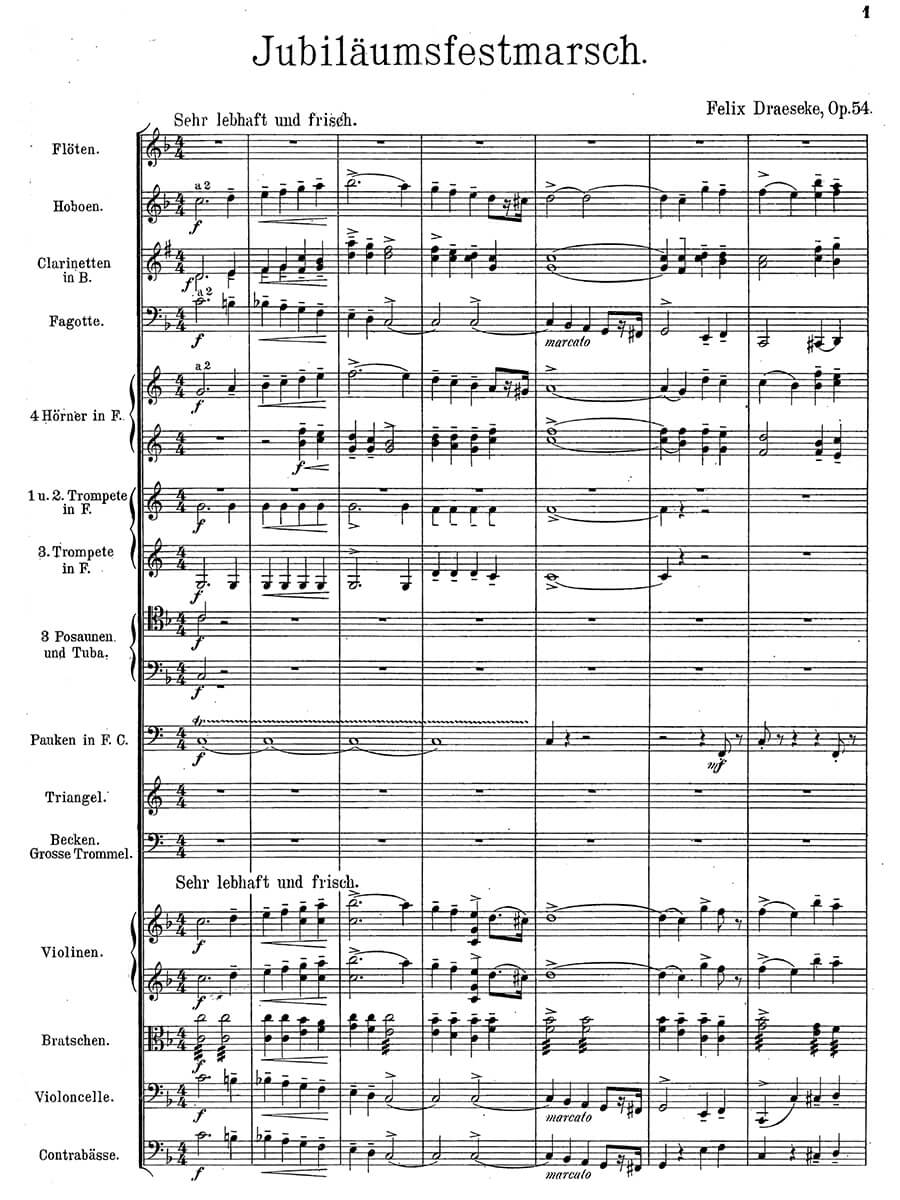Jubiläumsmarsch Op. 54 for full orchestra
Draeseke, Felix
20,00 €
Preface
Felix Draeseke – Jubiläumsfestmarsch, Op.54 (Jubilee Festival March) for full orchestra
(b. Coburg, 7 October 1835 — d. Dresden, 26 February 1913)
Preface
Felix Draeseke, like many composers before him, had to frustrate his parents’ intentions as regards a possible career – in this case, the church – to assert his determination to be a composer. He was born in Coburg, and when he was 17 entered the Leipzig Conservatoire where his teachers were Moscheles (piano), Franz Brendel (musicology) and Julius Rietz (composition). Meeting Hans von Bülow in Berlin in 1853 proved to a more immediate catalyst for the young man, as was hearing a performance of Wagner’s Lohengrin conducted by Liszt at Weimar, after which Draeseke started to write his own opera, König Sigurd. Meanwhile, his teachers at the Conservatoire were luke-warm about his progress there: Moscheles, for instance, wrote in his final report (1855): ‘Herr Draeseke only attended my classes to begin with and then withdrew, therefore I have nothing to report upon his progress.’ Brendel was the editor of the Neue Zeitschrift für Musik and suggested Draeseke write some articles for the publication once he had left the conservatoire. Although Rietz was rather half-hearted about his pupil’s ability, Draeseke thought highly enough of his teacher to ask for private tuition. Draeseke clearly positioned his sympathies with the New German School, both in his own compositions and in his written articles. His first attempt at a symphony (now known, Bruckner-like, as Symphony no. 0 – it is no longer extant) was performed at Coburg in 1856, and, having impressed Liszt with his aforementioned opera – to the extent that the Weimar master wanted to produce it – Draeseke settled in Dresden. Wagner was also complimentary about König Sigurd, although another work of his, the Germania-Marsch was given a most unfavourable reception at the composers’ conference in Weimar in1861. Further disappointment followed in 1862 when an overture for the birthday of Prince Constantin of Hohenzollern-Hechingen was so much disliked by the prince that it had to be withdrawn from a celebratory concert. Draeseke retreated to Switzerland in the face of these setbacks to teach piano. Pupils were hard to come by, but he started to make sketches for a number of new works. In 1865 on a visit to Munich to hear Tristan and Isolde he also consulted a specialist concerning an alarming deterioration of his hearing, something that had been an ongoing issue since he was a teenager and would worsen with age. He spent 14 ‘lost years’ in Switzerland after which he resettled in Dresden. These years, however, saw a reassessment of his stylistic outlook: a movement away New German School attitudes and a new search for balance and formal unity in his music. His first symphony proper saw the light of day in 1873 conducted by his teacher, Rietz. Here Draeseke’s future orientation is already very evident and is realized in his own special way: ‘With these works, which were followed by Gudrun [an opera] and the Symphonia Tragica [no.3], I had regained my equilibrium and become conscious of my artistic goal. As a child of my time and equipped with its means, I wanted to express its content musically but in respectful emulation of the great earlier masters. Their great achievements should be held high and valued side by side with those of the so-called Zukunftmusik.’ …
Read full preface > HERE
Score Data
| Edition | Repertoire Explorer |
|---|---|
| Genre | Orchestra |
| Printing | Reprint |
| Pages | 52 |
